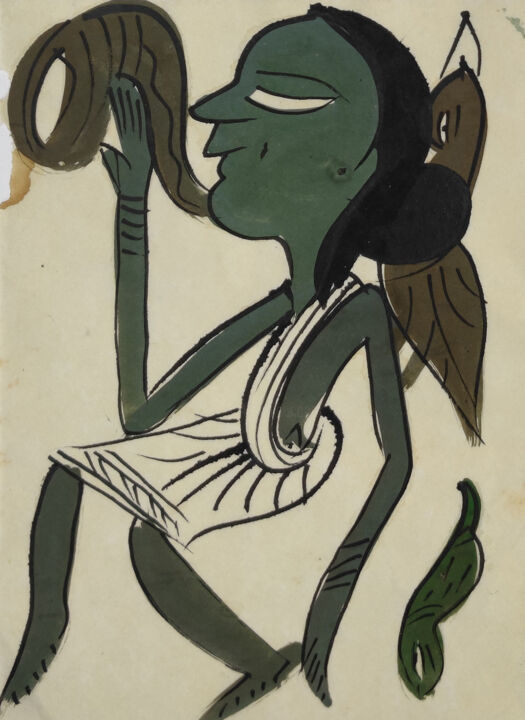
Fateci sapere se volete vedere altre foto di questa opera d'arte!
- Retro del lavoro / Lato del lavoro
- Dettagli / Firma / Superficie o struttura dell'opera d'arte
- Opera d'arte in situazione, Altro...
santhal Pattachitra -31 (2001) Pittura da Minmoy Das
Maggiori informazioni
- Confezione (Tubo) Tutte le opere sono spedite con cura protetta e assicurata, con un vettore premium.
- Controllo Controlla il tuo ordine fino alla consegna al compratore. Verrà fornito un numero di tracking per seguire la spedizione in tempo reale.
- Scadenza Consegna in tutto il mondo in 3-7 giorni (Stima)
- Dogana non inclusa Il prezzo non include le tasse doganali. La maggior parte dei paesi non ha tasse di importazione per le opere d'arte originali, ma potresti dover pagare l'IVA ridotta. Le tasse doganali (se presenti) devono essere calcolate all'arrivo dall'ufficio doganale e saranno fatturate separatamente dal vettore.
Maggiori informazioni
- Certificato di autenticità online tracciabile I certificati di autenticità possono essere verificati online in qualsiasi momento scansionando il codice dell'opera d'arte.
- Certificato di quotazione d'artista Gli esperti studiano il lavoro e la carriera di un artista. In seguito stabiliscono un valore medio, in modo indipendente e affidabile, del prezzo. Il valore medio dei prezzi colloca l'artista in una fascia di prezzo per un determinato periodo. Gli esperti possono essere invitati a stabilire una stima più precisa per un'opera in particolare.
Maggiori informazioni
Pagamento sicuro al 100% con certificato SSL + 3D Secure.
Maggiori informazioni
-
Opera d'arte originale (One Of A Kind)
Pittura,
Acquarello
su Carta
- Dimensioni Altezza 7,5in, Larghezza 5,5in
- Categorie Quadri sotto i 500 USD Arte tribale Vita di ogni giorno
Jamini Roy of the Bengal school, who, like many of his peers, understood the formal qualities, was the first among his peers to recognize the vitality of the myths and nature mysticism inherent in so called primitive and folk art. And he forged ahead visualizing valid alternatives in this art to mainstream western are introduced in the colonial period. A post modern and a contemporary artist in this age, he brought the Vaishnavite, Baul and Santal traditions visibility and precision in the world of art.
The Santhals are a tribe spread over the region of present day Bihar, Jharkhand and West Bengal states of the Indian subcontinent. Like any other tribe the Santals have an exclusive artistic perception rooted in their cultural traditions and physical environs.
The Santhals paint the walls of their huts during their village festival for ceremonial celebratory performances as also for self expression. They worship a stone, as a formless representation of the Divine, sing of the burthen of their life and provide a vivid portrayal of their day to day experiences, shared by animals and birds.
Done in primary colors, infested with leafy patterns in the foreground, background and borders, the Santhal paintings are characterized by a directness and a child like simplicity in the depiction of birds, animals and insects. The figures are static, frequently multicolor, artistic rather than realistic projections. Bodies of fish and birds are joined in one head. Mother and child as well as human, animal and bird couples are brought together by a philosophy of love and unions. A panoramic view of the village forms the backdrop, with women carrying firewood and water, men driving the bullock cart to the market, dancing and singing under a tree, a couple under flowering creepers; a family going for cultivation; men and women cutting wood, gathering fire wood, carrying water on the head; hunters returning with their catch ; fishing; taking mud pots in a cart to the village market for sale, flying kites and swinging, brothers of the bridegroom carrying the bride in a basket. These tell of the strong family bond and brimming with life diffusing a rare energy that animates Santhal art.
The colour scheme holds no logic. A bird or a fish appear in many colours. The picture is first drawn in black and then coloured. Originally, the Santhals used natural colours made from plants and stones, with a special and striking tinge. The older generation still sticks to natural colours while the young opt for synthetic colours. There also black and white paintings on canvas presented for archives or for sale today.
Santiniketan, a centre of excellence for Indian art, is associated with the iconic figure of Rabindranath Tagore, worldwide. The art of the Santhals gained prominence during his days Tagore got interested in the Santhals living in a hamlet close to Santiniketan and began to promote their art when he came across Nandalal Basu and appointed him as art teacher in Kala Bhavan. From this context arose an interest in folk arts and traditional crafts in Santiniketan and Sreeniketan. Soon an artist’s colony was established in 1930 near Santiniketan with Ramkinkar Baij, the Santhal painter and sculptor as one of its founding members. Today, those who visit Santiniketan come back with Ramkinkar indelibly etched in their memories.
Forms of arts change from age to age according to changing outlook, circumstances, methods and techniques. But folk art is brought into form in fidelity to natural and biological laws, operating within ethnological and geographical parameters. Today Santhal artists paint on canvases using acrylic for exhibitions and for sale although the older generation still sticks to their special colours obtained from plants, mud and other raw materials. The simplicity, virility and vitality of Santhal paintings, emerging from natural environs provide a fine chapter in the history of Indian arts, and needs to be sedulously nurtured.
Temi correlati
Tribal ArtFolk ArtIndian Tribal ArtIndian Folk ArtIndian Folk And Tribal Art






